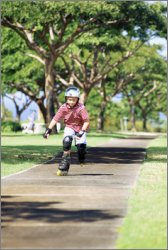Why is Rickets Disease Making a Comeback?
A 21st Century Warning Tale?
by www.SixWise.com
Rickets, a softening and weakening of bones in children typically
caused by vitamin D deficiency, was common in the 19th and
early 20th centuries.
|

Children, and adults, need some sun exposure to make
the bone-building vitamin D.
|
With the introduction of vitamin D supplements, however,
the disease, which can lead to bowlegs, stunted growth and
improper curvature of the spine, was largely eliminated by
the 1950s.
But history has a way of repeating itself, and now the crippling
bone disease is making a comeback, particularly among dark-skinned
kids.
"This potentially is a time-bomb," Dr. Laura Tosi,
bone health chief at Children's National Medical Center in
Washington told the Associated Press.
She was referring to the long-term effects of kids not building
strong bones during adolescence, which could lead to osteoporosis
later in life.
By the time a person reaches their 30s, their bone begins
to break down faster than it's replaced. During adolescence,
however, almost half of bone mass is developed.
The problem is that kids today are not receiving several
crucial components to build strong bones.
1. Not Enough Vitamin D
Vitamin D helps your bones absorb calcium and phosphorus.
If you don't get enough, your bones will become weakened,
yet government studies suggest that a growing number of Americans
are deficient in this important vitamin.
You skin makes vitamin D from sun exposure, and one of the
primary reasons why people, including kids, don't get enough
is because they're not spending enough time outdoors, or are
wearing sunscreen when they do (which blocks vitamin D production).
"Standing outside 15 minutes a day three times a week
lets the skin produce enough vitamin D most of the year,"
says Dr. Michael Holick of Boston University.
Because people with dark-pigmented skin require more time
in the sun to produce vitamin D, they are especially at risk
of vitamin D deficiency and, consequently, rickets.
Certain foods, such as milk and orange juice, are fortified
with vitamin D, but some natural health experts say the form
of vitamin D used for fortification is not ideal.
Foods that are naturally rich in vitamin D are fatty fish
like salmon and, to a lesser degree, mushrooms, organ meets
and egg yolks.
Researchers have also linked lower levels of vitamin D to
breastfed infants who do not receive supplemental vitamin
D. If a breastfeeding woman is low in the nutrient, then her
breastmilk will be as well. So while breastfeeding is still
the best choice, experts recommend supplementing babies' diets
with vitamin D.
2. Too Little Exercise
Exercise is a key component of bone growth. A tennis player's
dominant arm has 35 percent more bone than the non-dominant
arm, according to the Associated Press, and a recent Canadian
study found that postmenopausal women who got more exercise
as teens had 8 percent stronger bones than their less active
peers.
|

Getting plenty of exercise is at least as important
for kids' bone health as getting enough calcium, experts
say.
|
Yet children are increasingly spending their time watching
TV and playing video games instead of being active.
The result is not only increasing rates of childhood obesity
but also weaker bones in childhood and adulthood.
To help address the problem, a bone-growth guide has been
established by researchers at the Cincinnati Children's Hospital.
The guide will help pediatricians, who often miss the early
signs of rickets, to determine if a child's bone mass is at
a healthy level.
For now, you can help your child to build healthy bones by
getting outside for some safe
sun exposure. Experts say 15-20 minutes of sunlight a
day is an ideal amount for a light-skinned person to produce
health-promoting vitamin D. Darker skinned people need a bit
longer.
For times when you and your children cannot get out into
the sun, your health care provider can recommend a natural
vitamin D supplement.
And remember, staying physically active will also help your
child to build strong bones. So encourage him or her to play
sports, ride a bike, or do any other activity he enjoys. Even
10 or 20 minutes of activity a few times a week has been found
to improve bone strength in kids.
Recommended Reading
Calcium
Better From Food, Says New Study: Here are the 26 Top Calcium
Food Sources
Good
Posture: The Important Health Benefits of -- and Keys to --
Good Posture
Sources
NCTimes.com
December 23, 2007
CBSNews.com
October 27, 2003